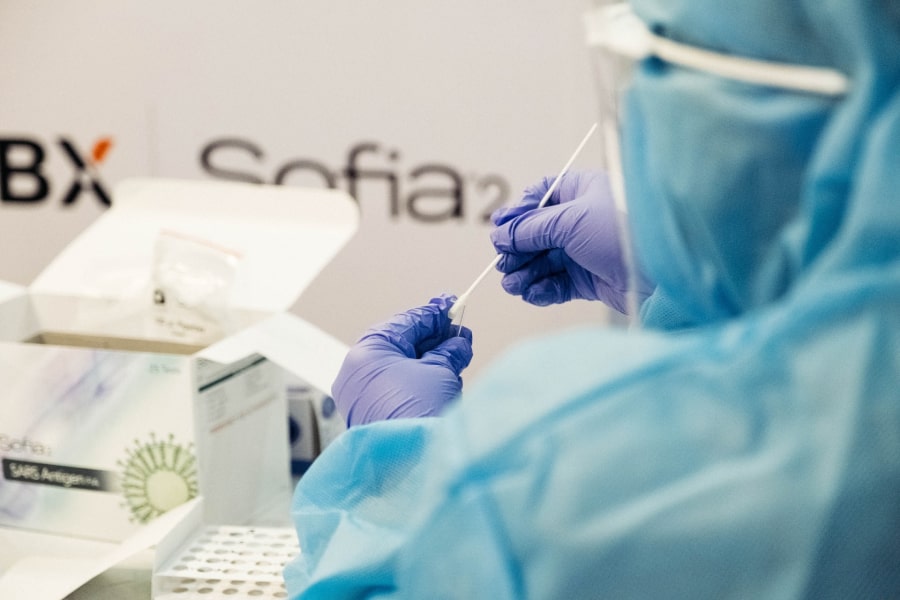Trade in COVID-19 related medical products: The Indian experience
The pandemic has evolved both as a challenge and an opportunity for India’s trade in medical products. The rising global demand for Indian COVID-19 vaccines may further give a boost to the sector. Nonetheless, it is also desirable for India to diversify its export destinations and export baskets so that any unforeseen future shocks do not have adverse effects on India’s exports.

Photo by JC Gellidon on Unsplash
While the COVID-19 pandemic resulted in significant demand and supply shocks for international trade, medical products trade actually increased during this time. The trade in COVID-19 related medical products was dominated by China, Germany and the US1. This article explores the trends in COVID-19 related medical products trade in the Indian context.
Global trade in medical products that were considered necessary to support the fight against COVID-19 was nearly US$ 1 trillion in 2018 (Kuriyama, 2020). Using the WTO classification system2, the comparative figure for India was US$ 26.22 billion in 2018, which improved marginally to US$ 27.37 billion in 2019 with gross exports and imports worth US$ 19.15 billion and US$ 8.22 billion respectively.
In terms of the shares, exports were between 5-6% of India’s total gross exports, while imports were between 1-2% of India’s total gross imports during 2017-19 period. Using the WCO-WHO joint classification system3, India’s total exports of COVID-19 medical products was reported at US$ 15.63 billion and imports at US$ 5.7 billion in 2019. Both classifications show India as a net exporter of COVID-19 related medical products4.
Out of the four categories of COVID-19 medical goods defined by the WTO (2020), India has been a net importer in three categories, namely, medical supplies, medical equipment and personal protective products (PPP) categories, but a net exporter of pharmaceuticals, which constitutes a share of 82% in the export of these four product categories. The magnitude of net exports in pharma products outweighs the net imports of the other three product categories, thereby making India a net exporter of the COVID-19 related medical products during 2017-19.
India’s leading export destinations for COVID-19 medical products have been the US, South Africa, Russia, Nigeria and Brazil. A deeper analysis of India’s export patterns in these products reveals that India has not actively used its FTAs to increase exports of medical products. Many of these COVID-19 medical products are not traded between India and its FTA partners though preferential tariffs on these products are significantly lower than the MFN tariffs, except in the case of Chile, in which case the difference between MFN tariffs and preferential tariffs is not much. On the contrary, the top 10 exporters of COVID-19 medical products, accounting for approximately 75% of exports of these products, are signatories to various free trade agreements5.
For imports of COVID-19 related medical prodcuts, India relies primarily on developed countries like Germany, the Netherlands, Belgium, Switzerland, and the US, and on developing countries like China, Indonesia and Brazil. For many of the COVID-19 related medical goods, India imported more than one third from China alone during the past three years and in some cases even more than three fourth. These include apparatus and equipment, thermometers, electro-cardiographs, extract of glands or other organs, opacifying preparations for x-ray examinations, diagnostic reagents for administration to patients, cationic organic surface-active agents, articles of apparel and clothing accessories, protective spectacles and visors, face masks, cleaning products, among others.
The deeper penetration of China in Indian medical imports is an outcome of China consolidating its position as a major upstream supplier in the Indian market (Ahmed, et al., 2020). Given that most of India’s exports of COVID-19 medical products consist of pharma products, import dependence for pharma inputs and supply shocks, such as the current pandemic, are bound to have repercussions on India’s ability to export pharma products to other countries.
As India was significantly dependent on certain developed and developing countries for majority of its COVID-19 medical imports prior to the start of this pandemic, it was caught unguarded when the virus started spreading in India and other countries. With limited domestic supplies and export restrictions in source countries, the prices of these products including masks, sanitizers etc., soared during the beginning of the crisis in India. However, the Indian industry quickly adapted to the new reality and expanded domestic production in many of the COVID-19 related products, such as PPE kits, masks, sanitisers, testing kits, etc., not only to meet domestic demand but also to export to other countries.
Thus, the pandemic has evolved both as a challenge and an opportunity for India’s trade in medical products. The rising global demand for Indian COVID-19 vaccines may further give a boost to the sector. Nonetheless, it is also desirable for India to diversify its export destinations and export baskets so that any unforeseen future shocks do not have adverse effects on India’s exports.
Production Linked Incentive (PLI) schemes aimed at enhancing manufacturing medical products may help in diversifying the production and export baskets. While developing the domestic industry, special emphasis should be given on quality. Competing with other countries, specially China, in the global market will be subject to offering superior quality products by Indian firms.
As a pandemic of this scale is usually associated with multiple waves of infection, the demand for related products is also here to stay in the near future. By increasing domestic production and engaging in gainful trade in COVID-19 related medical products, India can convert the present crisis into an opportunity.
Sources:
[1] https://www.wto.org/english/tratop_e/covid19_e/medical_goods_update_e.pdf, accessed on 20th February 2021.
[2] The World Trade Organisation (WTO) classification which includes 92 products and categorises them into four groups (WTO, 2020).
[3] The World Custom Organisation (WCO) and the World Health Organisation (WHO) joint classification which includes 53 products and categorises them into eight sections (WCO-WHO, 2020).
[4] The data was compiled fromWITS Database: https://wits.worldbank.org/
[5] The share of exports of medical products by the top exporters to their RTA partners ranges between 27% for China to almost 77% for the Netherlands. The US exports up to 60% of PPP to its RTA partners. (Source: https://www.wto.org/english/tratop_e/covid19_e/medical_products_report_e.pdf, accessed on 5th Feb 2021).

Dr. Pralok Gupta is an Associate Professor at the Centre for WTO Studies, Indian Institute of Foreign Trade, New Delhi.

Dr. Ayona Bhattacharjee is an Assistant Professor at International Management Institute (IMI Delhi). B 10, Tara Crescent, Block B, Qutab Institutional Area, New Delhi, Delhi 110016.













Leave a comment